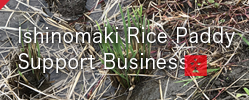A rice paddy field where the snow melts earlier than other fields
It’s the time before the rice planting season that corresponds to the period from winter to early summer. I try to sketch the agriculture in the Shonai district, even though my sketch seems extremely biased, using photos that were taken by a local photographer.
The first photo shows Akagawa river which runs near the Kushibiki area, Tsuruoka City in mid December. Akagawa is a first class river that runs east of central Tsuruoka City, about 40 km. long from south to north and flows into the Sea of Japan. In the old days, paddy rice fields were developed using the water of the river in Shonai plain (refer to an introduction page 1 of Akagawa shi, (the history of Akagawa river), by the Akagawa Land Improvement District, a social system and corporation whose purpose is to improve the quality of the soil). Though a long time ago, there was a confluence of the Akagawa river and the Mogami river at its basin, the land reclamation implemented in 1955 shifted the river direction to flow into the Sea of Japan, approximately 8 km south from the estuary of Mogami river. The river in the vicinity of Kushibiki that spans about 70 meters melt the snow and irrigate the land as it flows into the sea.
The photo below was taken in Shonaimachi and shows Mt. Chokaizan from a distance in late January. The rice paddy fields were completely covered with snow and so was the snowcapped Mt. Chokai in the distance. However as the sun continuously melts the snow and the water soaks into the land, it seems like the water is being stored in the earth.
By the way, regarding the snow...
I’ve heard that the snow that settles on the rice paddy field using the organic farming method melt earlier than the fields that are farmed using the traditional method. As you can see from the photo taken in mid January, it is clear that there is a difference between the left and right field separated by the ridge. It appears that the snow on the left is starting to melt already. The soil of the organic farm has a higher temperature so the snow melts quickly, the farm representative explained.
The next photo shows a plum grove in mid April. This is a plum grove in Yutagawa, Tsuruoka City. Yutagawa is famous for hot springs and the plum grove is located above the hot springs, overlooking the town.
Exactly at this time, farmers in Yutagawa also start the process that helps rice seeds germinate.
In March, they prepare the rice seeds. They first soak the seeds in salt water and segregate the good seeds filled with substance. Then they sterilize the seeds in order to kill bacteria that cause diseases. Some farmers use agricultural chemicals while others use a hot water disinfection method. The seeds absorb water that is necessary for germination. This is generally the process and the seeds are ready in April. They maintain a 30 degree Celsius temperature for the seeds to germinate. In the old days, farmers used a plastic container or a bathtub filled with warm water to soak the seeds but nowadays, most farmers use a germinating machine. They force the seeds to germinate so they can control the size of every sprout approximately 1 mm in length and facilitate the process subsequently.
The next photo shows Mt. Chokaizan once again. It is a distant view from Fujishima area in Tsuruoka City in late May. The snow on the mountaintop is almost gone and fresh water is flowing into the rice paddy field. The seedlings are planted in the regular pattern and the surface of the field full of water looks like a mirror.
The last photo is a shot taken in a cherry garden in early June. It reminds me of Sato Nishiki (delicious kind of cherries). By the time the peak season of Sato Nishiki is over, the Beni Syuho cherry season starts. (Beni-Syuho is made by hybridization of Sato Nishiki and another kind of cherry)
Cherries are not pollinated unless there are different kinds of cherries in the same area and this is known as cross pollination. The Sato Nishiki and the Beni Syuho are considered the perfect match for cross pollination. Dewashonai Tokusan farm have kept the bees that help with pollination of cherries.
Energy of passing the baton
From winter to early summer, the sun melts the snow and water runs down along the stream, soaking the rice paddy fields. The water temperature induces the rice seeds to germinate. Meanwhile, the water dissolves the nutrients and the soil becomes fertile, then the roots absorb the nutrients that makes the rice grow. On the other hand, the bees carry pollen and cherry trees bear fruit.
Rice and cherries photosynthesize, they convert solar energy into chemical energy through photosynthesis and offer this as food. Rice, cherries and water are all exposed to solar energy. This can be described as a complex course involving various players, passing the baton to the next player, a movement created by an energy that runs its natural course. A farmer cautiously takes part in passing the baton.


















